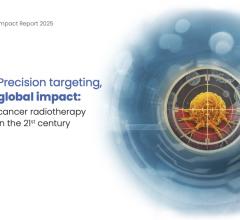According to the National Institutes of Health (NIH), precision-based medicine is an emerging approach for disease treatment and prevention that takes into account individual variability in genes, environment and lifestyle for each person. This allows doctors to better tailor a treatment protocol for each individual, rather than the standard “one-size-fits-all” approach that is based on average generalizations.
Although this term is fairly new, NIH states that the concept has been a part of healthcare for many years. And while the role of precision medicine is
still rather limited, this approach can be seen spreading across the field of healthcare, including radiation therapy.
New Uses for Radiation Therapy
So how does this tie into radiation therapy? One example is a new technology coming out of the Cleveland Clinic. Genomic-adjusted radiation dose (GARD) technology can optimize radiation therapy dosage based a patient’s tumor genomics.
Cleveland Clinic said the GARD technology, co-invented by Jacob Scott, M.D., of Cleveland Clinic and Javier Torres-Roca, M.D., of Moffitt Cancer Center, offers treatment teams a simple and reliable tool to match radiation dosage with a tumor’s molecular profile. The technology is being commercialized through CvergenX, a company founded by Torres-Roca.
“Radiation therapy has been one-size-fits-all when it comes to the dose of the radiation given,” said Scott, a physician-scientist in Cleveland Clinic’s Department of Translational Hematology and Oncology Research. “Radiation oncologists have made a lot of progress in shaping dosage — minimizing side effects and sparing healthy tissue — but the field has largely been left out of the genomics revolution sweeping through cancer care.”
The hope is that GARD and other initiatives like it will pave the way for more funding and support to work on customizing radiation therapy using the same genomics tools available in the rest of the oncology landscape. “As we bring radiation therapy into the era of precision medicine, we have an opportunity to make significant gains in this field that will help millions of patients,” said Scott.
Brain Cancer Diagnostics
A new report on the brain cancer diagnostics market, “Brain Cancer Diagnostics Market: Global Industry Analysis and Opportunity Assessment 2016-2026,” from Future Marketing Insights, projects that up to 78,000 new cases of primary brain tumors are expected to be diagnosed globally in 2017, with approximately 25,000 found to be malignant. As research into precision medicine continues, both patients and healthcare professionals are anticipating greater use of this type of healthcare model in the diagnosis and treatment of brain tumors. Healthcare facilities that are already focused on precision medicine-based treatments, such as the San Diego Gamma Knife Center (SDGKC), are working to set
the standard by which other treatment centers
will be measured.
Precision medicine is a driving factor in the expansion of the brain cancer diagnostics and therapeutics market, which is expected to grow extensively through 2025 to reach a value of up to $773 million, according to statistics from Grand View Research. HealthIT Analytics states that due to increasing interest, the federal government has allocated $34 billion to the NIH this year for the sole purpose of advancing precision medicine research. SDGKC points out that this initiative is especially important for brain tumor patients, because the survival rate is quite low.
As precision medicine-based research continues, scientists and physicians are finding that targeted approaches to treatment offer the most effective options when dealing with many types of brain tumors, according to a SDGKC statement regarding its new technology. The center said tools like the Gamma Knife stereotactic radiosurgery system can be used to precisely target tumors in the brain. In many cases where the Gamma Knife treatment option is utilized, brain tumors are successfully treated during one minimally invasive, outpatient appointment.
Paul Crowe, managing partner of the SDGKC, said, “Brain tumor patients have one of the hardest roads to travel when it comes to diagnosis and treatment. We’re confident that precision medicine is the right way to approach treatment, and since newer therapies can be tailored to each individual, successful treatment may be more likely.”
Robotic Radiosurgery
Accuray Inc. recently announced preliminary results from a prospective, phase I clinical trial evaluating adjuvant stereotactic partial breast irradiation (S-PBI) in early-stage breast cancer patients treated with the CyberKnife System. The study, published in the May issue of the peer-reviewed International Journal of Radiation Oncology - Biology - Physics, reported no recurrences or distant metastases at median follow-up of 26 months. In addition, according to the trial results at two years, more than 95 percent of patients and 100 percent of physicians rated cosmesis as excellent or good, indicating both patients and
physicians were satisfied with the appearance of the breast following treatment.
“The results of this phase 1 study highlight a new approach for treating breast cancer while minimizing tissue exposure. We believe our protocol offers reproducible and executable guidance for other radiation therapy teams interested in incorporating S-PBI into their practice,” said Asal Rahimi, M.D., M.S., assistant professor of radiation oncology, University of Texas Southwestern Medical Center, in Dallas, Texas. “Our study shows the benefits of real-time image guidance and motion control when
delivering S-PBI.”
According to Accuray, the CyberKnife System enables precise dose distributions to be confidently delivered to the patient with extreme accuracy over a minimum number of treatments, reducing side effects and preserving patients’ quality of life. This technology continually tracks and automatically adjusts the beam for movement in real-time, as the patient breathes normally, throughout the entire treatment session. In addition, the system’s sub-millimeter accuracy enhances clinicians’ abilities to treat effectively while preserving healthy tissue.
As technology continues to evolve at a rapid pace in the healthcare field, selecting the therapy that will work best for a particular patient is key to the advancement of precision medicine.
Radiation Therapy Treatment Systems Comparison Chart
ITN has created a Radiation Therapy Systems comparison chart of the specifications for these systems. This will require a login, but it is free and only takes a minute to register. The chart includes many manufacturers of Radiation Therapy Systems that are available in the United States.


 December 04, 2025
December 04, 2025 









